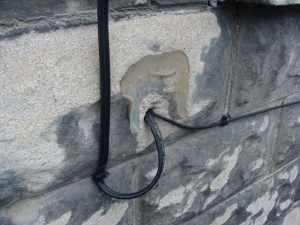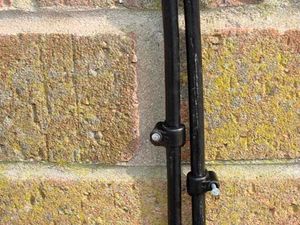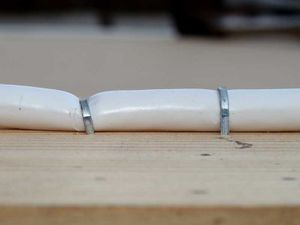Difference between revisions of "Cable for TV aerials"
(linkify, diagram) |
(→Cable Installation: pics) |
||
| Line 24: | Line 24: | ||
==Cable Installation== | ==Cable Installation== | ||
| + | [[image:393-mortar-joint.jpg|right|thumb|When clipping cables to hard bricks, its often easier to drive nails into the mortar rather than the brick.]] | ||
* Avoid sharp corners and kinks in the cable. | * Avoid sharp corners and kinks in the cable. | ||
* Avoid squashing the cable | * Avoid squashing the cable | ||
| + | [[image:393-staples-damage-cable.jpg|left|thumb|Staple fixing systems are easy, but a crushed co-ax will not transfer a signal well]] | ||
* Avoid long unsupported runs of cable, eg across [[:Category:Roofing|roofs]] | * Avoid long unsupported runs of cable, eg across [[:Category:Roofing|roofs]] | ||
* Clip exterior vertical cable runs frequently. A climbing plant can put a good deal of weight & wind load on [[cable]]. | * Clip exterior vertical cable runs frequently. A climbing plant can put a good deal of weight & wind load on [[cable]]. | ||
| Line 42: | Line 44: | ||
\___/ | \___/ | ||
| + | If drilling from inside with a [[SDS Drill]] to take great care with the exit hole - its very easy to blow out the facing of brick or stone leaving an ugly lump missing from the wall: | ||
| + | [[image:283-blast-cover-fail.jpg|300px]] | ||
==See Also== | ==See Also== | ||
Latest revision as of 21:26, 24 June 2013
Summary
- Use only CAI approved co-ax. Inferior types lead to picture freezes with digital reception, and interference on analogue TV.
- Don't be tempted to re-use leads already in place. Old non-CAI cable is sufficient for analogue, but not good for digital, and useless for satellite.
- Never use co-ax that is not designed for TV use. Some baseband co-axes look the same as TV aerial wire, but these cause heavy degradation, even with analogue TV signals.
- Use only black cable outdoors, other colours slowly degrade in sunlight.
- Don't kink the cable when installing.
Cable type
Co-axial (co-ax or coax) cable is invariably used for TV and Satellite aerial connections. For more information on co-ax, see main article Co-ax Cable
Choice of cable
This article gives a guide to choosing a suitable cable for a particular application.
A discussion of choice of aerial cable and connectors on uk.d-i-y and uk.tech.digital-tv.
Discussion of DAB aerials on uk.d-i-y
Cable Colour
As explained in Co-ax Cable, colour does matter when used outdoors. Only black cables are good for exterior use, other colours degrade in sunlight. The black pigment blocks the UV that does the damage.
Cable Installation
- Avoid sharp corners and kinks in the cable.
- Avoid squashing the cable
- Avoid long unsupported runs of cable, eg across roofs
- Clip exterior vertical cable runs frequently. A climbing plant can put a good deal of weight & wind load on cable.
- Fitting exterior vertical cable runs partially behind a downpipe makes them less visible and ensures load sharing of climbing plants, reducing strain on the cable.
- Use the suitably-sized round cable clips designed for mains use. Avoid using clips which deform the cable, as occurs with some non-mains clip types.
- Avoid using 50 ohm cable. It looks like just TV cable but is totally unsuitable. It gives heavy signal loss at TV frequencies.
- Where cable enters a wall, it is better to turn it downward, and then form a half loop so that water on the wire runs out from the wall instead of into the hole.
| | <--- cable | | _ | (_) <--- hole in wall | | | | <--- J shaped wire loop \___/
If drilling from inside with a SDS Drill to take great care with the exit hole - its very easy to blow out the facing of brick or stone leaving an ugly lump missing from the wall:


